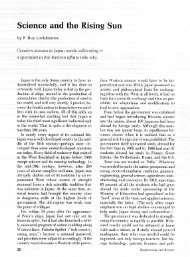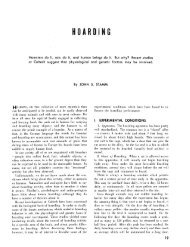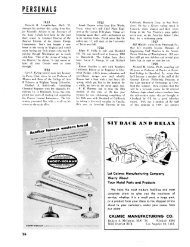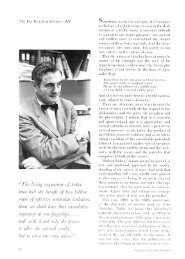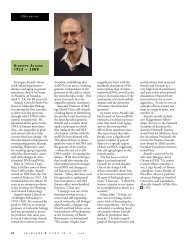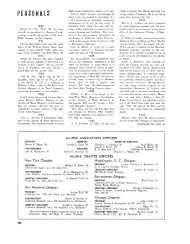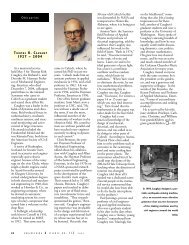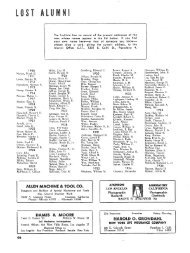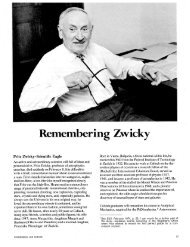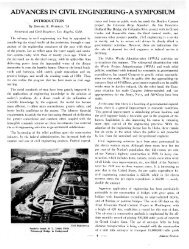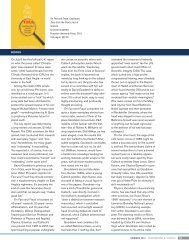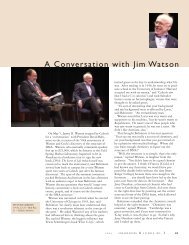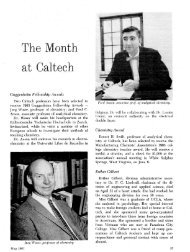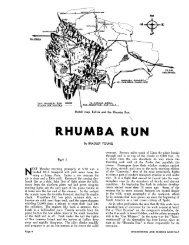The Science of Violin Making - Engineering & Science
The Science of Violin Making - Engineering & Science
The Science of Violin Making - Engineering & Science
You also want an ePaper? Increase the reach of your titles
YUMPU automatically turns print PDFs into web optimized ePapers that Google loves.
28 E N G I N E E R I N G & S C I E N C E N O . 4 2 0 0 4<br />
Photo by Akira Kinoshita
y Andrew Hsieh<br />
Itzhak Perlman in<br />
concert.<br />
Cremona Revisited:<br />
<strong>The</strong> <strong>Science</strong> <strong>of</strong> <strong>Violin</strong> <strong>Making</strong><br />
<strong>The</strong> lights dim, and a hush falls over the concert<br />
hall. <strong>The</strong> concertmaster rises, and as the orchestra<br />
tunes, the faint rustling <strong>of</strong> programs is heard in<br />
the background. Tonight’s concert features one<br />
<strong>of</strong> the greatest living soloists performing with the<br />
orchestra, and the anticipation is palpable. <strong>The</strong><br />
conductor appears and is duly acknowledged by<br />
the crowd; but he is not the one they are waiting to<br />
see. Finally, the soloist emerges, leaning on a pair<br />
<strong>of</strong> walking sticks, and takes his seat at center stage<br />
to thunderous applause.<br />
It is the distinguished violinist Itzhak Perlman,<br />
and the instrument in his hands is one <strong>of</strong> the finest<br />
string instruments ever made: the “Soil” Stradivarius,<br />
crafted in 1714 by the Italian master Antonio<br />
Stradivari. Even before the first notes have been<br />
played, members <strong>of</strong> the audience are transfixed by<br />
the sight <strong>of</strong> the violin, its brilliant red varnish and<br />
the stunning “flame” pattern <strong>of</strong> its back catching<br />
the eye as they reflect the bright stage lights. <strong>The</strong><br />
conductor raises his baton, and as the first notes<br />
reverberate through the hall, they complete the<br />
image <strong>of</strong> the renowned virtuoso and his legendary<br />
instrument.<br />
Each violin, viola, cello, and bass is a masterpiece,<br />
simple lumber converted into a sublimely<br />
expressive musical instrument. Most were made<br />
long before the musicians playing them were born.<br />
Musicians and violin makers claim that a violin’s<br />
sound improves with age, and therefore it is not<br />
entirely surprising that most musicians prefer older<br />
instruments.<br />
<strong>The</strong> best-known string instruments, with only<br />
a few exceptions, are the work <strong>of</strong> either Antonio<br />
Stradivari or Giuseppe Guarneri, both active in<br />
Cremona, Italy, in the first half <strong>of</strong> the 18th century.<br />
<strong>The</strong>ir violins were <strong>of</strong>ten passed down from<br />
virtuoso to virtuoso and sometimes named after<br />
famous past owners. Both Stradivari and Guarneri<br />
generated a sort <strong>of</strong> mystique about themselves<br />
by selling their instruments only to virtuosi or to<br />
extremely wealthy customers, and the quality <strong>of</strong><br />
2 0 0 4<br />
instruments such as those played by great soloists<br />
past and present has served to not only perpetuate<br />
but to increase the “Cremona mystique.” <strong>The</strong> two<br />
men maintained an extraordinary level <strong>of</strong> secrecy<br />
throughout their lives, suggesting that they might<br />
never have revealed some <strong>of</strong> their techniques to the<br />
world. <strong>The</strong> possibility <strong>of</strong> such secret techniques<br />
existing continues to provoke vigorous debate and<br />
experimentation, even after hundreds <strong>of</strong> years.<br />
A BRIEF HISTORY<br />
<strong>The</strong> violin family first appeared in northern<br />
Italy in the first half <strong>of</strong> the 16th century, and has<br />
changed little since the 1550s. Instruments made<br />
as early as 1560 are still in regular use today and<br />
are in most respects identical to their more recent<br />
counterparts.<br />
<strong>The</strong> years from 1650 to 1750 were a golden age<br />
<strong>of</strong> violin making. Nicolo Amati (1596–1684), the<br />
last and greatest <strong>of</strong> the Amati line <strong>of</strong> violin makers,<br />
was almost single-handedly responsible for the<br />
emergence <strong>of</strong> the many famous masters <strong>of</strong> the era;<br />
his students included Antonio Stradivari (1644–<br />
1737) as well as Andrea Guarneri (ca. 1626–1698),<br />
grandfather <strong>of</strong> the better-known Bartolomeo<br />
Giuseppe Guarneri (1698–1744).<br />
Antonio Stradivari and Giuseppe Guarneri<br />
departed significantly from previous designs, which<br />
had very highly-arched front and back plates, by<br />
building instruments with relatively flat bodies.<br />
<strong>The</strong>se were better able to withstand high string<br />
tensions and had greater carrying power in large<br />
concert halls. Stradivari’s violins were known for<br />
their brilliant tone color; Guarneri’s for their full,<br />
dark character.<br />
With the deaths <strong>of</strong> Stradivari in 1737 and<br />
Guarneri in 1744, the Cremonese school <strong>of</strong> violin<br />
making came to an abrupt end. Since then, their<br />
violins have been frequently copied. Some makers<br />
even built reputations for producing high-quality<br />
E N G I N E E R I N G & S C I E N C E N O . 4<br />
29
Below: <strong>The</strong> parts <strong>of</strong> a violin.<br />
From David Boyden et al., <strong>The</strong> <strong>Violin</strong> Family (New York: W. W. Norton & Co., 1989) p. 4.<br />
30 E N G I N E E R I N G & S C I E N C E N O . 4 2 0 0 4<br />
Right: X-ray cross sec-<br />
tions <strong>of</strong> a 1654 Amati<br />
violin (top) and a 1698<br />
Stradivari violin (bottom),<br />
showing the more gentle<br />
slope <strong>of</strong> the front and<br />
back plates in Stradivari’s<br />
instrument.<br />
replicas by painstakingly measuring every aspect <strong>of</strong><br />
the old instruments. However, while the copyists<br />
could duplicate the appearance <strong>of</strong> the Cremonese<br />
violins, they could never duplicate the sound.<br />
BUILDING A VIOLIN<br />
<strong>The</strong> violin appears simple at first glance, but it is<br />
one <strong>of</strong> the most complex musical instruments, built<br />
from more than 70 separate pieces <strong>of</strong> wood that are<br />
shaped and assembled by hand. No two violins are<br />
exactly alike; a trained ear can distinguish between<br />
individual violins. Whether it is a centuries-old<br />
masterpiece or a mass-produced fiddle, each violin<br />
has its own unique “voice.”<br />
Many <strong>of</strong> the features <strong>of</strong> the violin that appear<br />
merely ornamental are highly functional. <strong>The</strong> low<br />
vaulting <strong>of</strong> the front and back plates is essential for<br />
strength and for amplification <strong>of</strong> sound. <strong>The</strong> narrow<br />
middle bout, or waist, allows the player more<br />
room to bow on the highest and lowest strings.<br />
<strong>The</strong> purfling—the decorative trim around the<br />
edges <strong>of</strong> the instrument—protects the body from<br />
cracking, but also changes the dynamics <strong>of</strong> vibration<br />
considerably. Cutting the groove in which the<br />
purfling is inlaid allows the plates to vibrate as if<br />
they were hinged rather than clamped at the edge.<br />
<strong>The</strong> process <strong>of</strong> making a violin begins with the<br />
selection <strong>of</strong> materials. Choosing wood is an art<br />
in itself: it must be strong, flexible, and as dry as<br />
possible. Wood for violins is always cut during the<br />
cold dormant months, when the amount <strong>of</strong> sap in<br />
it is at a minimum, and “seasoned” for years under<br />
very dry conditions. <strong>The</strong> wood used in the best instruments<br />
is aged at least ten years, and sometimes<br />
as long as fifty years.<br />
Equally important is the process <strong>of</strong> shaping the<br />
front and back plates. <strong>The</strong> front plate is made from<br />
a s<strong>of</strong>twood, typically spruce, while the back plate<br />
Images courtesy <strong>of</strong> Steven A. Sirr, M.D.
From Neville H. Fletcher and Thomas D. Rossing, <strong>The</strong> Physics <strong>of</strong> Musical Instruments, figure 3.13, p. 79.<br />
Copyright © 1991, Springer-Verlag.<br />
Above: <strong>The</strong> resonant<br />
modes <strong>of</strong> a square plate<br />
with free edges. <strong>The</strong> X<br />
mode and the ring mode<br />
are the second and third<br />
ones, respectively, in the<br />
top row. <strong>The</strong> numbers<br />
below each mode are fre-<br />
quencies corresponding to<br />
the modes, relative to that<br />
<strong>of</strong> the first mode. Lines<br />
represent nodes, or places<br />
that remain stationary<br />
as the plate vibrates at a<br />
given frequency.<br />
IMAGE NOT LICENSED FOR WEB USE<br />
Below: Quarter-cut (left) and slab-cut (right) sections <strong>of</strong> a<br />
log, with the look <strong>of</strong> a violin back made from each. <strong>The</strong>se<br />
are the only cuts <strong>of</strong> wood used in violins; the s<strong>of</strong>twood<br />
front plate is traditionally quarter-cut while the hardwood<br />
back plate may be quarter-cut or slab-cut. In either case,<br />
the longitudinal axis is in the plane <strong>of</strong> the plate.<br />
From David Boyden et al., <strong>The</strong> <strong>Violin</strong> Family (New York: W. W. Norton & Co., 1989) p. 6.<br />
2 0 0 4<br />
is normally maple. <strong>The</strong> arched outer surfaces are<br />
carved rather than formed by bending. <strong>The</strong> arching<br />
gives the thin front plate increased resistance<br />
to the lateral force exerted by vibrating strings,<br />
and subtly alters the modes in which both plates<br />
vibrate. <strong>The</strong> violin maker carefully “tunes” the<br />
front and back plates, tapping the plates with the<br />
knuckles, listening for the characteristic “tap tones.”<br />
<strong>The</strong> pitches <strong>of</strong> different harmonics are adjusted by<br />
scraping away material as necessary. Tuning the<br />
front and back plates is easily the most demanding<br />
part <strong>of</strong> making a violin, and takes years to master.<br />
VIOLINS AND SOUND<br />
A vibrating string alone produces almost no<br />
sound, as it is too thin to sufficiently disturb the<br />
air. <strong>The</strong>refore, it is not the string itself, but the<br />
body <strong>of</strong> the violin, that actually generates its sound.<br />
When a string vibrates, the bridge rocks back and<br />
forth at the same frequency. <strong>The</strong> soundpost immobilizes<br />
the front plate directly beneath the right<br />
foot <strong>of</strong> the bridge, so that the right foot remains<br />
stationary, and the front plate is driven rapidly up<br />
and down by the left foot’s “pumping” motion.<br />
<strong>The</strong> bass bar, mounted lengthwise under the left<br />
foot <strong>of</strong> the bridge, reinforces the front plate and<br />
couples the upper and lower bouts so that they<br />
move together.<br />
<strong>The</strong> body <strong>of</strong> the violin has a number <strong>of</strong> resonant<br />
frequencies, or natural vibrational frequencies, at<br />
which a weak stimulus can cause large vibrations.<br />
Forced vibration <strong>of</strong> the top plate produces some<br />
amplification at any frequency, but the amount<br />
<strong>of</strong> amplification at a given frequency depends on<br />
how well it corresponds to one or more <strong>of</strong> these<br />
resonant frequencies. <strong>The</strong> bridge transmits a whole<br />
set <strong>of</strong> harmonics from a vibrating string to the<br />
front plate, and each harmonic is amplified according<br />
to the resonance generated at that frequency.<br />
<strong>The</strong> violin’s relative response levels to different<br />
frequencies create the instrument’s unique timbre<br />
by preferentially amplifying some harmonics and<br />
damping others.<br />
<strong>The</strong> resonant frequencies <strong>of</strong> the violin body as a<br />
whole depend most strongly on the resonant modes<br />
<strong>of</strong> the front and back plates. <strong>The</strong> plates themselves<br />
can be modeled most simply as two-dimensional<br />
panels, free to move at all points out to the edges.<br />
Just as a string vibrates in harmonics corresponding<br />
to standing waves on the string, a two-dimensional<br />
panel vibrates in specific resonant modes; the<br />
graphic above left shows the calculated resonant<br />
modes <strong>of</strong> a simulated square panel.<br />
In violins, there is a further complication:<br />
wood has very different mechanical properties<br />
along different axes. Its mechanical properties are<br />
determined entirely by its cell structure. Wood is<br />
made up <strong>of</strong> long, thin cells with walls composed <strong>of</strong><br />
the polymers cellulose, hemicellulose, and lignin.<br />
Cellulose, a carbohydrate that forms long straight<br />
E N G I N E E R I N G & S C I E N C E N O . 4<br />
31
<strong>The</strong> vibrational modes<br />
<strong>of</strong> the front plate (top)<br />
and back plate (bottom)<br />
<strong>of</strong> an unassembled violin<br />
made by a modern master<br />
craftsman are revealed<br />
by laser interferometry.<br />
Nodal areas appear white.<br />
<strong>The</strong> X modes and ring<br />
modes <strong>of</strong> both plates are<br />
highlighted in red. <strong>The</strong><br />
numbers are the frequen-<br />
cies at which the reso-<br />
nances occur.<br />
chains, is the main structural component <strong>of</strong> wood.<br />
Cellulose chains usually form micr<strong>of</strong>ibrils, fibers<br />
consisting <strong>of</strong> groups <strong>of</strong> parallel chains held firmly<br />
together by hydrogen bonding. In wood, cellulose<br />
micr<strong>of</strong>ibrils lie parallel to one another in four layers,<br />
and spiral around the cell in its long direction,<br />
with different angles <strong>of</strong> spiraling in each layer.<br />
Lignin and hemicellulose, which form highly crosslinked<br />
structures, act as a “glue” that holds together<br />
the cellulose components and binds adjacent cells<br />
together. <strong>The</strong> longest dimension <strong>of</strong> each cell runs<br />
parallel to the growth <strong>of</strong> the tree trunk, in the<br />
longitudinal axis, and therefore wood has its greatest<br />
tensile strength in the longitudinal direction.<br />
As a result, wood plates must be elongated along<br />
the grain <strong>of</strong> the wood, in the direction <strong>of</strong> greatest<br />
tensile strength, in order to achieve the same types<br />
<strong>of</strong> resonant modes that are observed in an ideal<br />
square plate.<br />
Many modern-day violin makers use visualizations<br />
<strong>of</strong> resonant modes to aid in tuning a violin’s<br />
front and back plates. During construction, modal<br />
patterns in a plate can be seen by covering the<br />
surface <strong>of</strong> the plate with a fine sand and inducing<br />
mechanical vibrations at various frequencies. As<br />
the plate resonates, the sand moves about, except<br />
at the nodes, which remain stationary. <strong>The</strong> sand<br />
collects at the nodes or is bounced away, creating<br />
much the same patterns as shown above.<br />
Two particularly strong modes are the second<br />
and fifth harmonics <strong>of</strong> the plate, <strong>of</strong>ten referred<br />
to as the “X mode” and the “ring mode” for the<br />
shapes <strong>of</strong> their nodal patterns. <strong>The</strong>se harmonics<br />
are the main components <strong>of</strong> a plate’s tap tone.<br />
Recently, a number <strong>of</strong> violin makers have recommended<br />
tuning each plate such that the ring mode<br />
sounds exactly an octave above the X mode, in<br />
32 E N G I N E E R I N G & S C I E N C E N O . 4 2 0 0 4<br />
order to mimic the efforts <strong>of</strong> early violin makers,<br />
who would have tuned the most prominent modes<br />
to exact musical intervals. While the theory is<br />
difficult to test, it seems highly plausible because<br />
tuning tap tones to musical intervals requires no<br />
specialized equipment and therefore could have<br />
been done by even the earliest violin makers. In<br />
addition, the idea parallels Renaissance ideals <strong>of</strong><br />
mathematical perfection, which may well have<br />
guided the Italian violin makers <strong>of</strong> centuries past.<br />
LUMBER REDUX: ANOTHER LOOK AT WOOD<br />
Do violins actually improve with age? <strong>The</strong><br />
acoustical properties <strong>of</strong> the wood used in their construction<br />
certainly change with the passage <strong>of</strong> years.<br />
Moisture in wood absorbs vibrational energy,<br />
converting it to heat energy by evaporation.<br />
Although the wood used in violins is already dry,<br />
minute changes in water content can have dramatic<br />
effects on violin acoustics: a 1 percent decrease in<br />
moisture content reduces damping by up to 3.5<br />
percent. <strong>The</strong> long-term improvement <strong>of</strong> acoustical<br />
response depends mainly on the degradation <strong>of</strong><br />
hemicellulose, the component <strong>of</strong> wood that adsorbs<br />
water most readily and degrades most dramatically<br />
over time. As hemicellulose degrades, the wood’s<br />
maximum water content decreases. Even over very<br />
short periods, the sound <strong>of</strong> a frequently played<br />
violin may noticeably improve as small amounts <strong>of</strong><br />
water evaporate from the wood.<br />
ANALYZING CREMONA<br />
Age, however, does nothing to explain the<br />
From C. M. Hutchins, et al., “Clarification <strong>of</strong> Free Plate Tap Tones by Hologram Interferometry,” Catgut Acoustical<br />
Society Newsletter, No. 16 (1971), p.15. Reprinted with permission <strong>of</strong> the <strong>Violin</strong> Society <strong>of</strong> America.
Above: <strong>The</strong> FFT spectra<br />
<strong>of</strong> the open (unfingered)<br />
A string on two violins,<br />
the 1725 Stradivari “Da<br />
Vinci” and a 2002 Joseph<br />
Nagyvary violin. (<strong>The</strong> A<br />
above middle C is tuned<br />
to 440 Hertz, a standard<br />
frequency also known as<br />
“international pitch.”)<br />
Courtesy <strong>of</strong> Joseph Nagyvary, www.nagyviolins.com.<br />
difference between Cremonese violins and their<br />
contemporaries. <strong>The</strong> recognized superiority <strong>of</strong> the<br />
Cremonese instruments must still be a result <strong>of</strong><br />
unique acoustical properties.<br />
One way to examine these properties is by<br />
performing a mathematical technique called a Fast<br />
Fourier Transform (FFT) on the waveforms that are<br />
generated when the violins are played. <strong>The</strong> sound<br />
waves produced by a musical instrument are the<br />
sum <strong>of</strong> the fundamental frequency <strong>of</strong> the note and<br />
all <strong>of</strong> its harmonics; the FFT breaks down a sound<br />
into its component harmonics and allows us to<br />
chart their relative strengths in what is known as an<br />
FFT spectrum.<br />
It is difficult to generate a steady waveform from<br />
a bowed string instrument, as the act <strong>of</strong> bowing the<br />
strings brings many unpredictable factors into play.<br />
<strong>The</strong>refore, FFT spectra are never perfectly consistent;<br />
large variations can occur even in spectra<br />
produced by a single instrument. Such variations<br />
might be worked around by mechanically vibrating<br />
the bridge to simulate constant, perfectly consistent<br />
bowing. <strong>The</strong> resulting FFT spectrum is steady and<br />
can be used to create a response curve that represents<br />
the amount <strong>of</strong> amplification generated by<br />
the body at any given frequency, as shown at right.<br />
Peaks on the response curve indicate resonant frequencies<br />
<strong>of</strong> the violin’s body, at which amplification<br />
is particularly high.<br />
<strong>The</strong>re are also easier ways to generate a response<br />
curve. Instead <strong>of</strong> simulating the full set <strong>of</strong> harmonics<br />
generated by the bowed string, one can produce<br />
the same results by vibrating the bridge at a range<br />
<strong>of</strong> pure frequencies, and measuring the resulting<br />
sound output in decibels. Ultimately, because<br />
body resonances are the main factor determining<br />
the tone quality <strong>of</strong> a violin, it is the response curves<br />
that provide the most insight into a violin’s acoustical<br />
properties.<br />
In 1985, German violin maker Heinrich Dünnwald<br />
compared the response curves <strong>of</strong> a group <strong>of</strong><br />
Cremonese violins to two control groups, one <strong>of</strong><br />
2 0 0 4<br />
violins built by master violin makers and one <strong>of</strong><br />
factory-made violins. <strong>The</strong> most striking contrast<br />
was seen at high frequencies. <strong>The</strong> Cremonese<br />
instruments showed a broad, strong maximum<br />
around 2500 Hertz (Hz), or vibrations per second,<br />
which is in the region <strong>of</strong> greatest human auditory<br />
sensitivity. <strong>The</strong>re was a large reduction <strong>of</strong> response<br />
above 3000 Hz. Modern master-crafted instruments<br />
showed an overly strong response in the<br />
same range, which explains modern violins’ widelyheld<br />
reputation for shrillness; factory-made violins<br />
had a consistently dull response above 2000 Hz.<br />
In a second experiment conducted the same<br />
year, Dünnwald found another characteristic trait<br />
<strong>of</strong> Cremonese violins: two <strong>of</strong> their response peaks<br />
are particularly strong. One peak, covering a fairly<br />
wide band located between 1300 Hz and 2500<br />
Hz, was sufficiently strong that virtually any note<br />
played on the instrument had its strongest harmonic<br />
within that range. <strong>The</strong> other peak occurred<br />
at the air resonance frequency, the natural resonant<br />
frequency <strong>of</strong> the air inside the violin rather<br />
than <strong>of</strong> the violin body itself. Nearly every tested<br />
Cremonese violin showed a strong response at that<br />
frequency, as shown on the next page. In the vast<br />
majority <strong>of</strong> the other tested violins, both peaks<br />
were much weaker.<br />
<strong>The</strong> Dünnwald experiments demonstrated conclusively<br />
that there is a clear acoustical difference<br />
between violins made by Stradivari and Guarneri,<br />
How a response curve corresponds to FFT measurements.<br />
<strong>The</strong> FFT <strong>of</strong> a vibrating string (top) decreases smoothly with<br />
increasing frequency. <strong>The</strong> violin’s body (middle) amplifies<br />
harmonics that correspond to its resonant modes, while<br />
other harmonics are amplified very little. <strong>The</strong> sound we<br />
hear (bottom) thus has a very different FFT spectrum than<br />
does the string in isolation.<br />
E N G I N E E R I N G & S C I E N C E N O . 4<br />
33<br />
Adapted from Colin Gough, “<strong>Science</strong> and the Stradivarius,” Physics World (April 2000).
From H. Dünnwald, “Ein Verfahren zur objektiven Bestimmung der Klangqualität von<br />
<strong>Violin</strong>en,” Acustica, Vol. 58, (1985) pp. 162-169.<br />
and contemporary violins. <strong>The</strong> characteristic<br />
Cremona sound appears to be the result <strong>of</strong> strong<br />
selective amplification <strong>of</strong> several key harmonics.<br />
<strong>The</strong> cause <strong>of</strong> this amplification remains an open<br />
question.<br />
VARNISH AND SALT<br />
For many years it was fashionable to study the<br />
varnish used by both Stradivari and Guarneri—the<br />
brilliant, reddish hue <strong>of</strong> their instruments suggested<br />
that their varnish was unique. <strong>The</strong> claim most<br />
commonly made by violin makers was that a secret<br />
recipe for varnish was the most important factor<br />
in tone quality. However, varnish is unlikely to<br />
improve the sound <strong>of</strong> a violin. Its only acoustical<br />
effect is to damp vibrations, and because its main<br />
function is to form a hard protective layer over the<br />
exterior <strong>of</strong> the instrument, it is highly implausible<br />
that any varnish could selectively damp very high<br />
frequencies. Furthermore, ultraviolet photography<br />
has revealed that most <strong>of</strong> Stradivari’s and Guarneri’s<br />
violins have lost much <strong>of</strong> their original varnish,<br />
and have been recoated in the last 150 years with<br />
modern varnishes. Since many modern violin<br />
makers believe that their violins sound better “in<br />
the white” than varnished, the best thing to do<br />
with varnish may simply be to use less <strong>of</strong> it.<br />
<strong>The</strong> process <strong>of</strong> “stewing,” or gently heating wood<br />
in a salt solution before drying, was also identified<br />
as a likely difference between the Cremonese<br />
school and the modern day. Analysis <strong>of</strong> wood<br />
shavings provides strong circumstantial evidence<br />
that Guarneri stewed his wood. <strong>The</strong> main effect <strong>of</strong><br />
stewing is to substantially accelerate the degradation<br />
<strong>of</strong> hemicellulose, so the hemicellulose content<br />
<strong>of</strong> stewed wood should be far lower than is normal<br />
for its age. From comparison <strong>of</strong> growth rings to<br />
known climate data, we know that the wood in<br />
Guarneri’s instruments cannot have been cut more<br />
than two decades before the instruments were<br />
34 E N G I N E E R I N G & S C I E N C E N O . 4 2 0 0 4<br />
Left: Dünnwald’s second experiment. L is the relative<br />
strength <strong>of</strong> the air resonance frequency in decibels, and N<br />
is the percentage <strong>of</strong> possible notes for which the strongest<br />
harmonic is between 1300 Hz and 2500 Hz. <strong>Violin</strong>s made<br />
by the old Cremonese masters are indicated by squares,<br />
and other violins are indicated by dots.<br />
made, yet the hemicellulose levels in the wood are<br />
what would be expected for wood three or four<br />
decades older.<br />
But stewing was hardly a secret; on the contrary,<br />
it was a familiar process long before the 18th<br />
century. Evidence for it exists as early as 1580,<br />
when French chemist Bernard Palissy wrote: “Salt<br />
improves the voice <strong>of</strong> all sorts <strong>of</strong> musical instruments.”<br />
<strong>The</strong> purposes usually stated for stewing<br />
were to prevent rot, to repel woodworm, and to<br />
stabilize water content. <strong>The</strong> last does not enhance<br />
acoustic response, but guards against cracking by<br />
preventing rapid changes in water content. Salt<br />
actually does this by hydrogen-bonding to water<br />
itself, slightly increasing the wood’s water content<br />
and partially <strong>of</strong>fsetting the effect <strong>of</strong> hemicellulose<br />
degradation.<br />
<strong>The</strong> stewing theory has another flaw: there is<br />
no evidence that Stradivari stewed his wood. By<br />
the early 18th century the process was gradually<br />
passing out <strong>of</strong> standard practice. It has seen a<br />
resurgence in recent years, but still only a few violin<br />
makers practice it routinely.<br />
THE SECOND COMING OF STRADIVARI?<br />
If varnish and salt are not the answers, then<br />
Joseph Nagyvary, a biochemistry pr<strong>of</strong>essor at<br />
Texas A&M University who moonlights as a violin<br />
maker, claims to be closer to knowing the secrets<br />
<strong>of</strong> the Cremonese masters. Recently he has gained<br />
notoriety in musical circles for making violins that<br />
show an amazing similarity to those <strong>of</strong> Stradivari<br />
himself. As a violin maker, Nagyvary was familiar<br />
with the extant literature on Cremonese violins;<br />
as a chemist, he gradually became convinced that<br />
physical characteristics alone could not adequately<br />
explain the Cremonese sound. He therefore hypothesized<br />
that Stradivari and Guarneri used some<br />
form <strong>of</strong> wood treatment that substantially altered<br />
the composition or structure <strong>of</strong> the wood itself. To
Joseph Nagyvary applies<br />
varnish to a violin in his<br />
workshop in College Sta-<br />
tion, Texas.<br />
Photo by Kathleen Phillips, Texas A&M AgNews, August 2003.<br />
test this hypothesis, he acquired and analyzed wood<br />
shavings from Stradivari instruments.<br />
Nagyvary discovered that these instruments were<br />
made with wood containing extremely large quantities<br />
<strong>of</strong> embedded minerals, suggesting immersion<br />
in some mineral salt solution. However, he was<br />
unable to develop a wood treatment method that<br />
would cause sufficient penetration <strong>of</strong> minerals into<br />
the wood.<br />
Eventually Nagyvary stumbled upon an unexpected<br />
answer to this problem. He currently<br />
constructs violins with timber salvaged from the<br />
bottom <strong>of</strong> Lake Superior. For over three centuries<br />
logs were floated to lumber mills across the lake<br />
chained together in large “rafts,” and some became<br />
sufficiently waterlogged to break away and sink<br />
to the bottom. Decades <strong>of</strong> soaking have left the<br />
wood heavily impregnated with a variety <strong>of</strong> mineral<br />
residues which, as Nagyvary discovered, closely<br />
matched the mineral content <strong>of</strong> wood shavings<br />
from one Stradivari cello.<br />
Nagyvary’s revised theory is that Stradivari and<br />
Guarneri stored their wood in mineral-rich brackish<br />
water for years before beginning to dry it out.<br />
This storage allowed minerals to seep in and fill<br />
the empty space left as microbes digested hemicellulose<br />
in the wood. Nagyvary even suggests that<br />
18th-century treatises calling for dry storage with<br />
no additional treatment may have been a deliberate<br />
deception aimed at obscuring the practices <strong>of</strong><br />
the masters. <strong>The</strong> acoustical effect <strong>of</strong> embedded<br />
minerals is not yet well understood, but Nagyvary’s<br />
experiments suggest that microscopic mineral crystals<br />
may modify resonant modes by stiffening wood<br />
in some directions and adding flexibility in others.<br />
BAROQUE TUNING<br />
In addition to treating wood differently from<br />
modern practice, the Cremonese masters designed<br />
their instruments to fit specifications that distinguish<br />
them from their modern counterparts.<br />
Most significantly, the tap tones <strong>of</strong> all early Italian<br />
violins are tuned distinctly lower than those <strong>of</strong><br />
other violins. This in turn produces response peaks<br />
at lower frequencies. <strong>The</strong> difference is on the order<br />
<strong>of</strong> a half-step or a whole-step, which makes sense<br />
when one notes that Baroque orchestras commonly<br />
tuned to pitches that were approximately that far<br />
below modern standards. <strong>Violin</strong> makers may have<br />
begun to tune their tap tones to higher frequencies<br />
to match a late 18th-century rise in orchestral tuning<br />
pitch, affecting the violin’s timbre in ways that<br />
they could not have predicted.<br />
CODA<br />
Although much has been discovered about the<br />
acoustics <strong>of</strong> violins in recent years, whether we<br />
have truly unlocked the secrets <strong>of</strong> Stradivari and<br />
2 0 0 4<br />
From J. Meyer, “<strong>The</strong> Tonal Quality <strong>of</strong> <strong>Violin</strong>s,” <strong>The</strong> Journal <strong>of</strong> the Catgut Acoustical Society,<br />
May 1984. Reprinted with permission <strong>of</strong> the <strong>Violin</strong> Society <strong>of</strong> America.<br />
<strong>The</strong> distribution <strong>of</strong> the most prominent tap tones <strong>of</strong><br />
100 violins. f 0 is the air resonance; f 1 is the first body<br />
resonance. 17th- and 18th-century Italian instruments<br />
are marked with numbered circles; black circles indicate<br />
Stradivari violins.<br />
Guarneri remains in question. Craftsmanship and<br />
design are likely as important to achieving highquality<br />
sound as any purported secret recipe or<br />
technique, and there may be no substitute for three<br />
hundred years <strong>of</strong> graceful aging.<br />
<strong>The</strong> present is an exciting time for violin makers<br />
and researchers alike. Acoustical analysis <strong>of</strong> Cremonese<br />
violins has, by revealing the specific patterns<br />
that define the Cremona sound itself, given<br />
violin makers a target to aim for. <strong>The</strong> exact way in<br />
which these patterns were achieved is still unclear,<br />
but new ways <strong>of</strong> looking at old instruments have<br />
generated plausible scientific explanations for many<br />
aspects <strong>of</strong> the art <strong>of</strong> violin making, as well as theories<br />
and avenues <strong>of</strong> research that could lead to further<br />
breakthroughs. Regardless <strong>of</strong> whether all the<br />
secrets <strong>of</strong> Stradivari and Guarneri are ever found,<br />
such technical advancements help contemporary<br />
violin makers fulfill every violin maker’s ambition:<br />
to produce instruments that violinists might be<br />
proud to play three centuries from now.<br />
Andrew Hsieh (BS ’04, biology) wrote this paper<br />
for the Core 1 science writing class. Hsieh plays both<br />
violin and viola, and is also active as a composer. He<br />
performed in both the Caltech chamber music program<br />
and the Occidental-Caltech Symphony Orchestra<br />
as an undergraduate. He is currently a member <strong>of</strong><br />
the Division <strong>of</strong> Biology research staff and plans to go<br />
to medical school. Hsieh’s faculty mentor for the paper<br />
was Jed Buchwald, the Dreyfuss Pr<strong>of</strong>essor <strong>of</strong> History.<br />
In the spring <strong>of</strong> 2004, the faculty modified the Core<br />
1 requirement to emphasize technical writing for journals.<br />
A new course on science writing for the public,<br />
En 84, is now <strong>of</strong>fered at the Hixon Writing Center.<br />
E N G I N E E R I N G & S C I E N C E N O . 4<br />
35



